CMOs are UP AGAINST IT right now.
They’re fielding more frequent and intense questions from CEOs and boards, their budgets and staff are leaner than ever, they’re asked to show attribution without the right tools or models in place, they’re juggling a million responsibilities, grappling with the implications of the Dark Funnel and AI, and they are STRESSED.
And that isn’t even the whole list of what’s on their plates these days.
So it doesn’t come as a surprise that CMO tenure has fallen to an average of 1-3 years, fractional CMOs are on the rise, and marketing leaders and companies are opting out of the CMO position entirely.
The frustration is clear in this thread from the r/marketing SubReddit responding to the question, “What are the real challenges of any CMO?”:

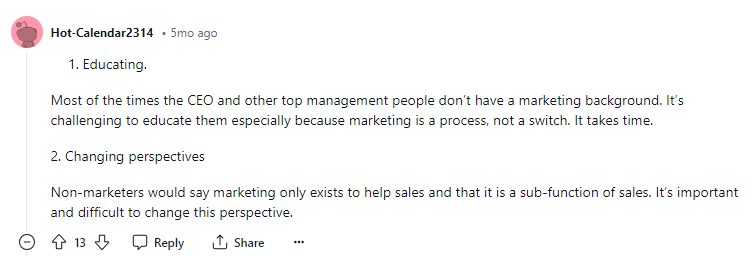
And also today on “Things that make you go ‘oof!’” Matt Heinz’s list of comments from his weekly CMO Coffee Talks really show the stress CMOs are feeling these days and paint a clear picture of their professional (and personal) challenges.

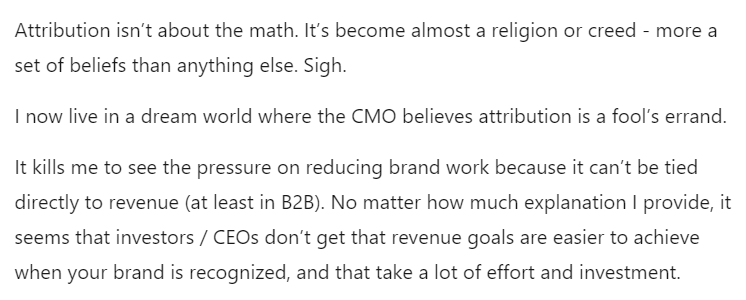
Obviously, it’s rough out there. And as marketers who provide products for marketers, we want to help.
Even though we understand the inherent issues with “proving marketing value” — we’re on your side, the value is obvious — it’s still a question marketing leaders have to answer in increasing frequency.
To help you field those inevitable questions and hopefully ease some stress of the job, here’s the latest in our Insight to Action series focusing on content insights CMOs can use to:
- make clear plans
- prioritize projects for their teams
- align with their counterparts in sales and enablement leadership
- improve content, content processes, and customer experiences with content
- market marketing to internal teams, C-suites, and boards
Since we drink our champagne here we will be using our own solution, Bigtincan Content, as an example. But whether you’re “one of us” or not, we hope this will be useful to you.
Content engagement insights for CMOS to improve internal marketing, prioritization, sales alignment, and buying journeys
Insight #1 - Sales content adoption
You see your team pumping out all this content while requests continue to roll in.
Your first step is to make sure your team isn't working tirelessly at the content factory only for most of it to go unused.
Here’s your opportunity to hit PAUSE, audit your content catalog to see what you already have (whether it’s you, your content marketers, or some representatives from your team and sales enablement), and analyze how often, if at all, and which content is being used by your sales team.
A master repository containing and tracking usage on all of your content makes this 1000x easier for obvious reasons, so part of your initial project may be seeking out and consolidating all your team’s content that has made its way into the wild into one central location.
Then you can work your way toward a dashboard like this one that monitors sales usage of marketing content, AKA Story Activity:

Some context: Stories are containers for individual pieces of groups of content.
Or this one that monitors user (AKA seller) engagement:
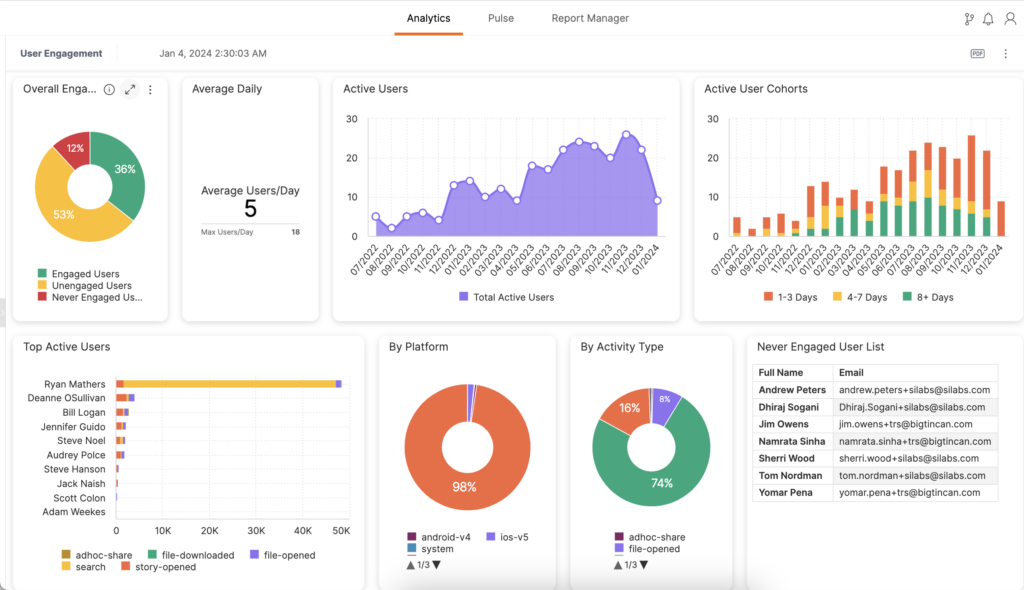
*Slaps hood of dashboard* With analytics like these you can see content trends, which Stories are opened most, which are never opened, who from your internal teams has viewed or engaged with the content in same way (either by liking, commenting, bookmarking, or sharing), and who has never looked at a single thing relating to marketing content in their entire life. At least in their lifetime of having these tools available.
So those are the insights. Now what? Let’s break it down insight by insight:
Stories opened and shared the most by sellers: These are your models for success (especially if customer engagement with these assets is also high — more on that later). This is the kind of content your team should prioritize, repurpose, distribute, and create more of.
Stories never opened or shared: Take a closer look at these assets individually.
Are they outdated? Do they have some shortcomings that are easily fixed like old branding, product information, or some minor copy issues?
If not, now is the time for some internal marketing and content distro. TALK to your sellers. Maybe they simply don’t know about this content yet. Maybe they’re filed under hard-to-search keywords. Maybe they were part of an old business initiative that’s no longer a priority.
And if they’re still not used after circulation or repurposing, hit that delete button. A cluttered catalog could be another reason for low adoption.
Some sellers not signing it or looking at content at all: This is your opportunity as a marketing leader to work with sales and enablement leaders to enforce content adoption, form strategies for content awareness, and align go-to-market teams around messaging and content usage.
Because your team can create, publish to multiple channels, and shout about content from the rooftops all you want, but if sales and enablement leaders who work directly with sellers every day don’t support content adoption, usage will remain low.
As CMO you can help your team be more effective (and be more effective in your own role) if you regularly align with leaders in other departments. Having the data behind you will help you make the case that their support is required.
Insight #2 - Buyer engagement with content
In the words of Bigtincan’s own head of marketing, SVP Pam Dearen, “All of the precious marketing resources that are often limited go into creating what we believe is going to be the most effective material for the sellers throughout the buyer's journey. But how do we know? Are they using it? Is it working?
Without any kind of tooling and insights, we're guessing, or we're just not sure if we're making an impact in all the right places. So it is a very difficult challenge.”
Knowing whether and how your sales team is using content is great — and lacking this data is one of the top frustrations among revenue teams — but it’s only one side of the coin. What’s more important for you as a CMO is understanding whether and how your audience is engaging with content after sellers share it with them.
Customer engagement insights tell you what your team should spend time on and what they shouldn't. They also tell you what your customers care about most (and least), which helps hone messaging and content plans so they resonate better with your audience. Even if sellers like a piece of content, if the customers they share it with don’t respond, then you know it’s time to replace that asset with something more aligned to your customer’s needs.

In Bigtincan we monitor customer engagement with content through what we call Shares (shown above) and Digital Sales Rooms (shown below).
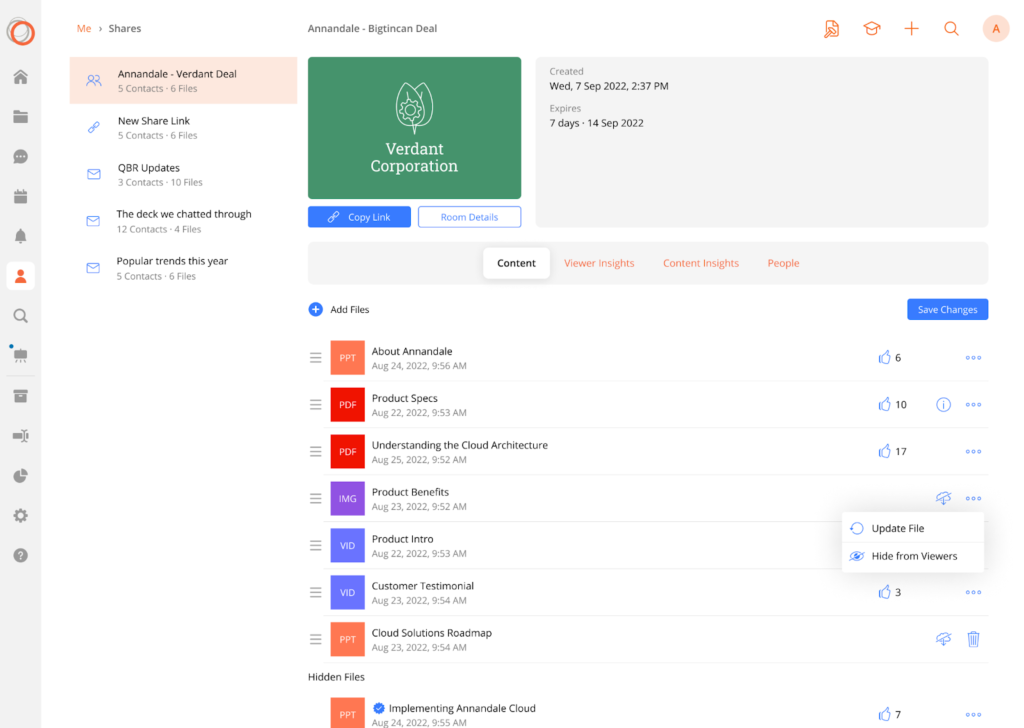
These give you direct views of how customers respond to your content. They show you:
- What content sellers sent
- Which of those pieces of content customers actually opened
- Which pieces they ignored
- Which pieces they opened and spent time on, down to the slide or page level
- Which pieces they opened and promptly exited out of
- Which pieces they liked or disliked
- What content they downloaded for later use (or to share with their team)
And each of these insights give you and your sales team direction on what to do next to further engage each customer by showing you what they consider worth their time and what they don’t.
Insight #3 - Content impact on deals
This is the big one. The one everyone’s asking for. A dashboard linking content (and marketing outputs) to deals closed and revenue numbers. Can it be real or is this just hype?
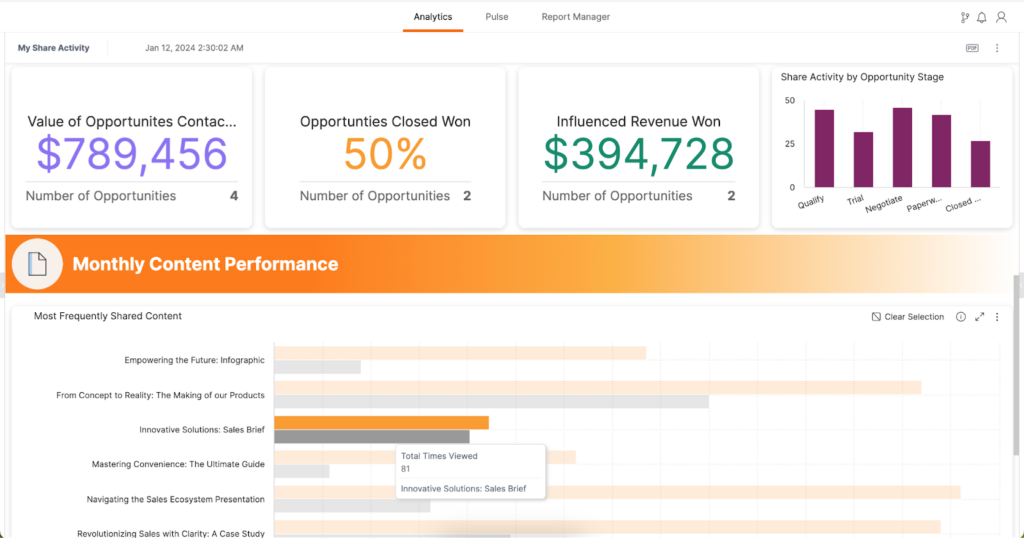
In all honesty, it’s real. But it IS a custom dashboard. It doesn’t come out of the box, but you can build it.
A content revenue dashboard like this helps you demonstrate the value of marketing efforts at a moment's notice and defends your team in times of increased questioning.
It also lets you drill into those microdetails like when during the buyer’s journey certain content is most effective and which individual pieces of content have contributed the most revenue over time.
Whatever tool or environment you’re working in, the ability to set up something like this is the key to marketing marketing to people who are focused solely on numbers like sellers and board members, with the additional boons of improving your team’s content processes as well as your customers’ experience.
And that should help relieve at least some of your daily stressors as CMO.
Real life, non-hypothetical example of content insights to action
Now let’s put the spotlight on some actions other marketing teams have taken following content insights.
While this review from TrustRadius may be from the “before” times, the use case remains the same (with some improvements).
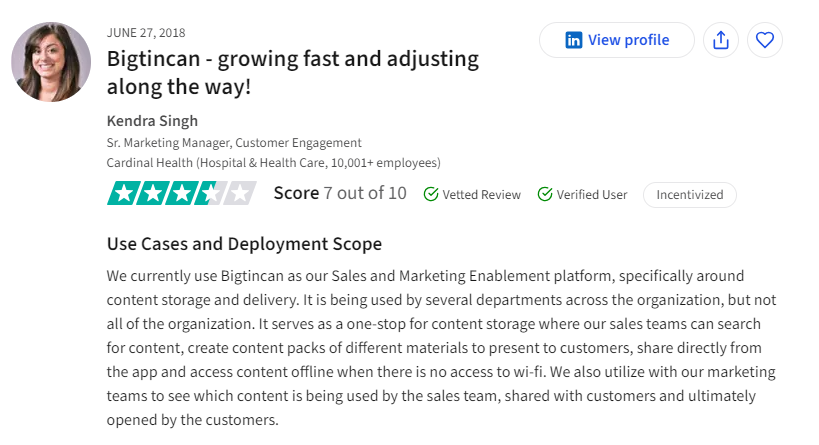
And here’s how FieldTurf has empowered their marketing team to reduce content requests and focus on creating only the most engaging content possible.
Take action!
As a CMO, staying busy with the right things and showing the results of those actions will prove beneficial to you.
Armed with these insights, maybe you can get your partnerships and priorities in order to beat this Redditor’s challenge to CMOs:

And while you’re at it, check out the rest of our (continually growing) Insight to Action series for some other nuggets of wisdom in these trying times:
